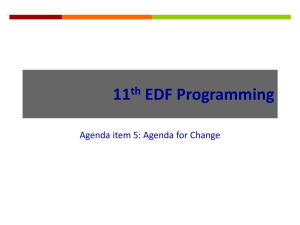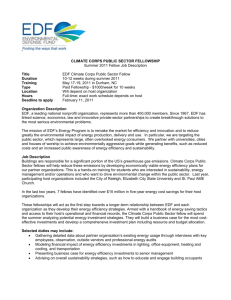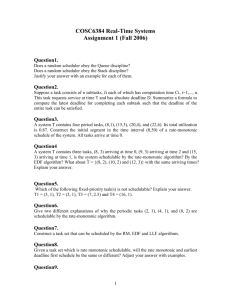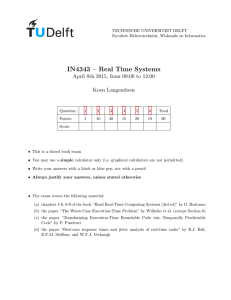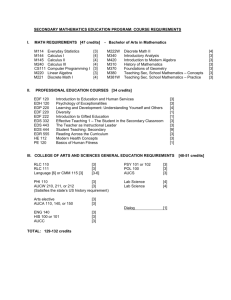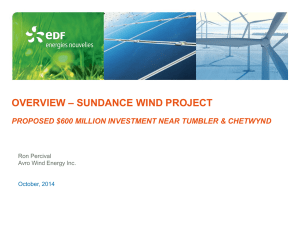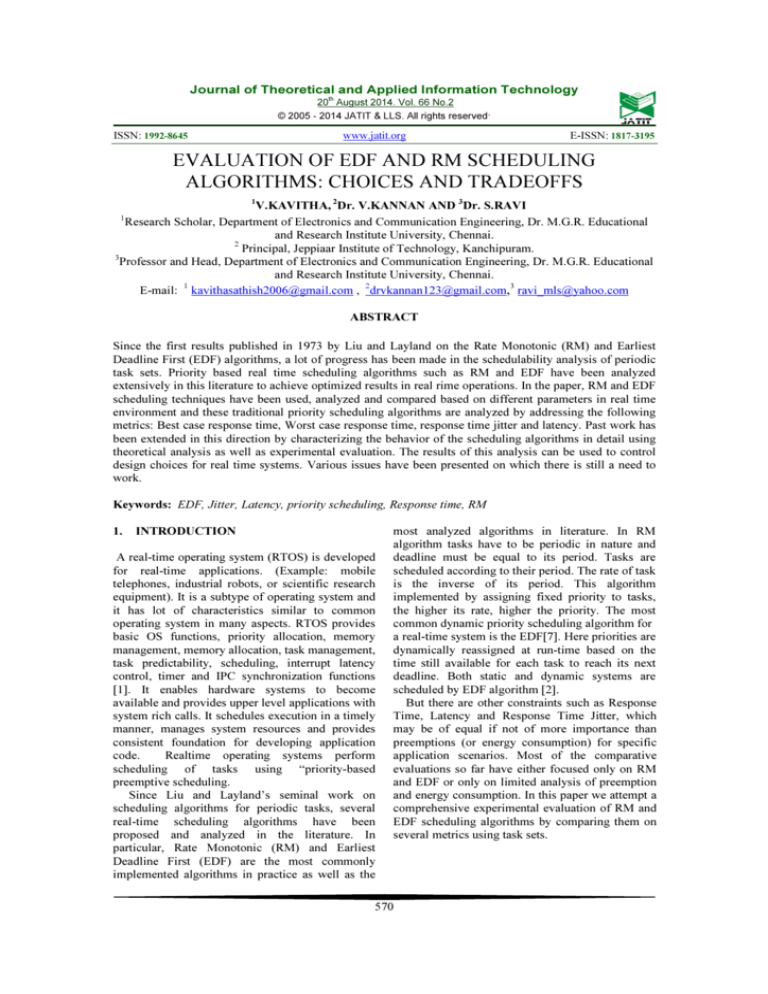
Journal of Theoretical and Applied Information Technology
20th August 2014. Vol. 66 No.2
© 2005 - 2014 JATIT & LLS. All rights reserved.
ISSN: 1992-8645
www.jatit.org
E-ISSN: 1817-3195
EVALUATION OF EDF AND RM SCHEDULING
ALGORITHMS: CHOICES AND TRADEOFFS
1
V.KAVITHA, 2Dr. V.KANNAN AND 3Dr. S.RAVI
Research Scholar, Department of Electronics and Communication Engineering, Dr. M.G.R. Educational
and Research Institute University, Chennai.
2
Principal, Jeppiaar Institute of Technology, Kanchipuram.
3
Professor and Head, Department of Electronics and Communication Engineering, Dr. M.G.R. Educational
and Research Institute University, Chennai.
E-mail: 1 kavithasathish2006@gmail.com , 2drvkannan123@gmail.com,3 ravi_mls@yahoo.com
1
ABSTRACT
Since the first results published in 1973 by Liu and Layland on the Rate Monotonic (RM) and Earliest
Deadline First (EDF) algorithms, a lot of progress has been made in the schedulability analysis of periodic
task sets. Priority based real time scheduling algorithms such as RM and EDF have been analyzed
extensively in this literature to achieve optimized results in real rime operations. In the paper, RM and EDF
scheduling techniques have been used, analyzed and compared based on different parameters in real time
environment and these traditional priority scheduling algorithms are analyzed by addressing the following
metrics: Best case response time, Worst case response time, response time jitter and latency. Past work has
been extended in this direction by characterizing the behavior of the scheduling algorithms in detail using
theoretical analysis as well as experimental evaluation. The results of this analysis can be used to control
design choices for real time systems. Various issues have been presented on which there is still a need to
work.
Keywords: EDF, Jitter, Latency, priority scheduling, Response time, RM
1.
INTRODUCTION
A real-time operating system (RTOS) is developed
for real-time applications. (Example: mobile
telephones, industrial robots, or scientific research
equipment). It is a subtype of operating system and
it has lot of characteristics similar to common
operating system in many aspects. RTOS provides
basic OS functions, priority allocation, memory
management, memory allocation, task management,
task predictability, scheduling, interrupt latency
control, timer and IPC synchronization functions
[1]. It enables hardware systems to become
available and provides upper level applications with
system rich calls. It schedules execution in a timely
manner, manages system resources and provides
consistent foundation for developing application
code.
Realtime operating systems perform
scheduling of tasks using “priority-based
preemptive scheduling.
Since Liu and Layland’s seminal work on
scheduling algorithms for periodic tasks, several
real-time scheduling algorithms have been
proposed and analyzed in the literature. In
particular, Rate Monotonic (RM) and Earliest
Deadline First (EDF) are the most commonly
implemented algorithms in practice as well as the
most analyzed algorithms in literature. In RM
algorithm tasks have to be periodic in nature and
deadline must be equal to its period. Tasks are
scheduled according to their period. The rate of task
is the inverse of its period. This algorithm
implemented by assigning fixed priority to tasks,
the higher its rate, higher the priority. The most
common dynamic priority scheduling algorithm for
a real-time system is the EDF[7]. Here priorities are
dynamically reassigned at run-time based on the
time still available for each task to reach its next
deadline. Both static and dynamic systems are
scheduled by EDF algorithm [2].
But there are other constraints such as Response
Time, Latency and Response Time Jitter, which
may be of equal if not of more importance than
preemptions (or energy consumption) for specific
application scenarios. Most of the comparative
evaluations so far have either focused only on RM
and EDF or only on limited analysis of preemption
and energy consumption. In this paper we attempt a
comprehensive experimental evaluation of RM and
EDF scheduling algorithms by comparing them on
several metrics using task sets.
570
Journal of Theoretical and Applied Information Technology
20th August 2014. Vol. 66 No.2
© 2005 - 2014 JATIT & LLS. All rights reserved.
ISSN: 1992-8645
2.
www.jatit.org
RELATED WORK
3.
A. R.R.Maggavi, D.A.Torse implemented an
embedded platform for RM algorithm using uc/os-II.
In this paper, RM scheduling is implemented on
uc/os-II and its operation in terms of processor
utilization and task execution time were discussed.
ROM image file was ported into 8051 based
microcontroller flash and tested for scheduling with
RMA. The results have indicated optimum utilization
of processor with RMA scheduler for realizing low
cost hardware and software for developing embedded
system. The overall CPU utilization was 70.18% with
RMA approach using 8051 [8].
B. Biju
K
Raveendran
attempted
a
comprehensive experimental evaluation of six
different scheduling algorithms by comparing them
on several metrics using simulated task sets.
Scheduling algorithms for periodic tasks, several
real-time scheduling algorithms have been proposed
and analyzed in the literature. In particular, Rate
Monotonic (RM) and Earliest Deadline First (EDF)
are the most commonly implemented algorithms in
practice as well as the most analyzed algorithms in
literature. More recently, the proliferation of mobile
embedded computing devices running on limited
battery power has brought to focus the issue of
power-aware computing – in particular power-aware
scheduling. Among the factors affecting power
consumption, context switching is one that is often
clearly identified as ‘overhead’. A few real-time
scheduling algorithms have been proposed with the
aim of reducing the number of preemptions. But most
of the comparative evaluations so far have either
focused only on RM and EDF or only on limited
analysis of preemption and energy consumption [9].
C. Omar U. Pereira Zapata, Pedro Mejıa Alvarez
implemented the best known partitioned and global
multiprocessor scheduling algorithms and to compare
their performance. The performance of the global and
the partitioned algorithms were compared using RM
and EDF scheduling policies under off-line and
online algorithms. Performance evaluation study was
designed with the aim to introduce the conditions
under which some algorithms are better than the
others and as a future reference for the design of new
algorithms. Extensive simulation experiments were
conducted to evaluate the performance and
computational of the algorithms. In our simulation
experiments, the schedulability tests were evaluated
for different values and number of tasks [10].
E-ISSN: 1817-3195
PARAMETERS FOR COMPARISON
Response Time
It is the time taken in an interactive program from
the issuance of the command to the commence of the
response of the command.
3.1
Here, worst case and best case response times
under EDF and RM scheduling are going to be
discussed.
3.2 Response Time Jitter
Jitter is the size of the variation in the arrival or
departure times of a periodic task. Jitter normally
causes no problems as long as the actions all stay
within the correct period.
Response time jitter refers to maximum length of
the interval in which a task can be released nondeterministically.
3.2 Latency
Latency is a measure of the time between a
particular task and a system’s response to that task,
and it’s quite often a focus for real-time
developers.
For a task τi, we define the maximum input-output
latency as Li = maxi(finish-time– start-time)
4.
SCHEDULABILITY ANALYSIS
In 1973, Liu and Layland analyzed properties
of two basic priority assignment rules: the Rate
Monotonic (RM) algorithm and the Earliest
Deadline First (EDF) algorithm. According to RM,
tasks are assigned fixed priorities ordered as the
rates, so the task with the smallest period receives
the highest priority. According to EDF, priorities
are assigned dynamically and are inversely
proportional to the absolute deadlines of the active
jobs. The major contribution of Liu and Layland
was to derive a simple guarantee test to verify the
schedulability of a periodic task set under both
algorithms. Each periodic task τi is considered as an
infinite sequence of jobs τi,k (k =1, 2, . . .). Each
job is characterized by a worst-case execution time
Ci, a relative deadline Di and an absolute deadline
di,k =ri,k + Di (ri,k) is the arrival time of task) [4].
The ratio Ui =Ci /Ti is called the utilization
factor of task τi and represents the fraction of
processor time used by that task. The value,
n
∑
Ui
(1)
i =1
is called the total processor utilization factor and
represents the fraction of processor time used by the
periodic task set. Clearly, if Up >1 no feasible
571
Journal of Theoretical and Applied Information Technology
20th August 2014. Vol. 66 No.2
© 2005 - 2014 JATIT & LLS. All rights reserved.
ISSN: 1992-8645
www.jatit.org
E-ISSN: 1817-3195
schedule exists for the task set with any algorithm. If 5.1.1 Worst-case response time analysis
Up ≤1, the feasibility of the schedule depends on the
Under RM scheduling, assuming Di ≤ Ti, the
task set parameters and on the scheduling algorithm worst-case response time of task τi, is given by the
used in the system.
well-known equation[5].
The basic schedulability conditions for RM and
EDF proposed by Liu and Layland were derived for a
set of n periodic tasks under the assumptions that all
tasks start simultaneously at time t = 0, relative
deadlines are equal to periods (that is, di,k =k Ti ) and
tasks are independent. Under such assumptions, a set
of n periodic tasks is schedulable by the RM
algorithm if [5],
Ri
Ri = Ci +
∑ Tj Cj
j∈hp(i )
(4)
Here, Ci is the maximal execution time, Ri is the
response time for task τi and the set hp(i) consists of
all tasks with higher priority than task τi. Priorities
are assumed to be unique and tasks will not
voluntarily suspend themselves. The terms in the
summation express how many times each higher
n
1
/
n
priority task will interfere with task τi multiplied with
Ui ≤ 2 − 1
(2)
the higher priority task’s execution time, Cj. To solve
i =1
the above equation the response time, Ri, must be
RM algorithm is able to feasibly schedule task sets factored out.
with processor utilization up to about 88%.
This is in general impossible. Therefore one must
Under the same assumptions, a set of n periodic iterate on Ri with the following formulation:
tasks is schedulable by the EDF algorithm if and
n
only if[3],
∑
Rin+1 = Ci +
n
∑
Ui≤1
(3)
i =1
5.
PRELIMINARIES
In this paper, a performance analysis of two
scheduling algorithms is carried out where the
priorities of the tasks are assigned statically (using
RM) and dynamically (using EDF). The problem to
be studied is to schedule a set of n real-time tasks τi =
τ1, τ2,…τn, and a task is usually a thread or a process
within an operating system. The parameters that
define a task are: the execution time Ci, the period Ti,
and the deadline Di[6]. It is considered that only
periodic and preemptive tasks may be executed in the
system. Each periodic task, denoted by τi, is
composed of an infinite sequence of jobs. The period
Ti of the periodic task τi is a fixed time interval
between release times of consecutive jobs. Its
execution time Ci is the maximum execution time of
all the jobs. The period and the execution time of task
τi satisfies that Ti > 0 and 0 < Ci < Ti = Di; (i = 1…...
n).
5.1 Response Time Analysis
To analyze response times of EDF and RM
algorithms, the idea is that tasks sometimes must be
activated at the same time, called a critical point. A
task set is schedulable when all tasks are activated at
the same critical point and all deadlines are met. A
critical point will always appear in a system provided
no task in the set has an offset.
∑
Ri
Cj
Tj
j∈hp(i )
(5)
Where n is the iteration number. In the first
iteration the first response time, Ri1 , is usually set to
the task’s execution time, Ci. Then it is iterated until
two subsequent response times are the same, or when
the last response time exceeds the task’s deadline.
Under EDF scheduling, the calculation of worstcase response-time analysis is more complicated and
based on the theorem “the worst case response time
of task τi is found in a busy period in which all tasks
are released synchronously at the beginning of the
period at the maximum rate”.
The worst-case response time of task τi is given by,
[ [
Ri = maxCi, max{Li(a) − a}
]
(6)
a≥0
Where the busy interval Li (a) is given by the
equation,
a
Ci
Ti
Li(a) = Wi{a, Li(a) } + 1+
(7)
Here, a denotes the arrival time or release time
of task and d=a+ Di, L is the constant delay of
arrival time and Ri, the response time of task. Where
the higher-priority workload Wi {a,Li(a)} is given
by,
572
_
Journal of Theoretical and Applied Information Technology
20th August 2014. Vol. 66 No.2
© 2005 - 2014 JATIT & LLS. All rights reserved.
ISSN: 1992-8645
www.jatit.org
E-ISSN: 1817-3195
Real-time programmers commonly handle tasks
Li(a) a+Di−Dj
with
tight jitter requirements in one of two ways:
Wi{a, Li(a) } = ∑ min
,1+
Cj (8)
Tj
Tj
j≠1,Dj≤a+Di
• If only one or two actions have tight jitter
requirements, set those actions to be top priority.
Only a finite number of values of a must be Note: This method only works with a very small
checked when evaluating the above equation.
number of actions.
• If jitter must be minimized for a larger number of
5.1.2 Best-case response time analysis
Under RM scheduling, exact best-case analysis has tasks, split each task into two, one which computes
recently been developed for the case D≤ T. The best- the output but does not pass it on, and one which
case response time of task τi is given by the equation passes the output on. Set the second task’s priority
to be very high and its period to be the same as that
of the first task. An action scheduled with this
Ri n
approach will always run one cycle behind
n+1
Ri = Ci +
−1 Cj
(9)
schedule, but will have very tight jitter.
Tj
j∈hp(i )
Most real-time systems use some combination of
b
these
two methods.
Where Ci denotes the best-case execution time
of task τi.
6. TASK MODEL AND METHODOLOGY
Under EDF scheduling, no exact best-case analysis
In this section– Rate Monotonic (RM) and Earliest
is known to exist. A trivial lower bound, Ri, on the
Deadline First (EDF) priority scheduling algorithms
best-case response time of task τi is given by,
are going to be implemented using an example so that
the ensuing discussion and analyses are clear. Both
(10)
Rib = Cib
these algorithms are priority based scheduling
This is actually a quite good bound for the algorithms for periodic tasks with hard deadlines.
shortest-period tasks. The longest-period tasks can, Table 1 show the example task set. We took the
however, have much longer best-case response times, following assumptions in our presentation of the
especially if the system load is high. A tighter lower algorithms:
bound on the best-case response time can be obtained
by interference analysis, our proposed lower bound, • Arrival times for first instances of all tasks are
assumed to be 0.
Ri b, is given by the equation
• Period (J) for a job J is the same as period (T)
where J is an instance of task T.
b
•
For
each job J, deadline (k) = arrival time (k) +
{Ri , Di−Dj}
period (k). All instances of a periodic task should
(11)
Rib = Cib + min
−1Cjb
Tj
have the same computation time.
•
All
instances of a periodic task should have the
This expression provides only a lower bound, since
same
relative deadline, which is equal to the
it does not take any initial (partial) interference from
period.
task Tj into account. It is possible to improve the
∑
∑
formula slightly by including some obvious cases
where initial interference must occur. It is
conjectured, however, that the expression for the
exact best-case response time is as complex as the
formula for exact worst-case response time under
EDF.
Table 1: Example task set
5.2 Jitter Analysis
So far, it is assumed that tasks are released at a
constant rate (at the start of a constant period) .This is
true in practice and a realistic assumption. However,
there are situations where the period or rather the
release time may ’jitter’ or change a little, but the
jitter is bounded with some constant. The jitter may
cause some task missing deadline and certain systems
might require that jitter be minimized as much as
possible.
Task
Arrival time(for
first instance)
Period
(ms)
Execution
time(ms)
τ1
τ2
τ3
0
0
0
4
5
20
1
2
7
This job list is derived from Table 1 under our
assumption deadline (k) = arrival time (k) + period
(k) for any job k. These jobs are arranged in the order
of deadline and when the deadline is same, in the
order of arrival – as this is the likely arrangement of a
queue.
573
Journal of Theoretical and Applied Information Technology
20th August 2014. Vol. 66 No.2
© 2005 - 2014 JATIT & LLS. All rights reserved.
ISSN: 1992-8645
www.jatit.org
Table 2: Job list for table 1
Job
E-ISSN: 1817-3195
worst case response time of RM algorithm can be
computed using the equation (5),
Execution
time (ms)
1
Deadline
k1(τ1)
Arrival
time (ms)
0
k2(τ2)
0
2
5
k3(τ1)
4
1
8
k4(τ2)
5
2
10
k5(τ1)
8
1
12
k6(τ2)
10
2
15
k7(τ1)
12
1
16
k8(τ3)
0
7
20
k9(τ2)
15
2
20
k10(τ1)
16
1
20
Ri
4
n+1
=
Ri n
Cj
Ci + ∑
Tj
j∈hp(i )
(5)
When priorities are set as fixed the response times
of tasks can be calculated. We begin with the highest
priority task τ1. No other task will interfere its
execution, so the response time will be equal to its
maximal execution time 1.
R τ11 =1 ;( Best case response time of first task)
the response time for the next highest priority task,
τ2, is then calculated. Only one task, τ1 has higher
priority and will interfere with τ2. Response time
for τ2 is calculated as:
R τ21= 2+2/4*1=2+1=3
EDF (Jobs)
R τ22= 2+3/4*1=2+1=3
k1 k2 k8 k3 k4 k8 k5 k8 k6 k7
k8
k9 k10
(First iteration response)
R τ21=R τ22=3;
The sequence of iterations terminates with the
response time 3 for task τ2.
Next task to consider is τ3, which will be
interfered by two higher priority tasks. The
response time iterations are:
0 1 2 3 4 5 6 7 8 9 10 11 12 13 14 15 16 17 18 19 20
t (ms)
Figure 1: Timeline execution of EDF algorithm
R τ31= 7+7/4*1+7/5*2=7+2+3=12
RM (Jobs)
R τ32= 7+12/4*1+12/5*2=7+3+6=16
k1 k2 k8 k3 k4 k8 k5 k8 k6 k7 k8 k9 k10 k9 k8
R τ33= 7+16/4*1+16/5*2=7+4+8=19
R τ33= 7+19/4*1+19/5*2=7+5+8=20
R τ34= 7+20/4*1+20/5*2=7+5+8=20
R τ33= Rτ34=20
6.1.2 Best case response time
The best case response time of RM algorithm
can be computed using the equation (9) as shown.
0 1 2 3 4 5 6 7 8 9 10 11 12 13 14 15 16 17 18 19 20
t (ms)
Figure 2: Timeline execution of RM algorithm
A task set is schedulable when all tasks are
activated at the same critical point and all deadlines
are met. A critical point will always appear in a
system provided no task in the set has an offset.
6.1 Calculation Of RM Algorithm Parameters
6.1.1 Worst case response time
For the given task set τ1=4ms, τ2=5ms,
τ3=20ms, C1=1ms, C2=2ms and C3=7ms, the
Ri n
Rin+1 = Ci + ∑
−1 Cj
Tj
j∈hp(i )
(9)
It is calculated for all the jobs using the same
iterative method used for worst case response time.
574
R τ1b=1;
Journal of Theoretical and Applied Information Technology
20th August 2014. Vol. 66 No.2
© 2005 - 2014 JATIT & LLS. All rights reserved.
ISSN: 1992-8645
www.jatit.org
R τ2b=2;
R τ3b=12;
6.1.3 Output jitter
Output jitter and constant is compute for each
task if response-time analysis is done. Let Ri and
Rbi denote, respectively, the worst-case and bestcase response times of task τi. The jitter, Ji, is then
given by,
Ji= R i- Rib
(12)
J τ1=0; J τ2=1 and J τ3=8 respectively under RM
scheduling for the given task set.
6.1.4 Latency
Another parameter that it is important to
minimize in control applications is the input-output
latency. Assuming that a control task τi acquires
inputs at the beginning of each instance and
delivers control outputs at the end, the maximum
input-output latency is defined as,
Li = maxi(finish-time– start-time)
It is also defined as,
Li= Rib
(13)
Under RM scheduling,
L τ1=1;L τ1=2 and L τ3=12 respectively.
So, R τ1b= C τ1b=1;
R τ2b=1.25;;
{7,20−5}
{7,20−4}
Rτ3b =7+min
−1*2+min
−1*1
5
4
=8.55;
6.2.3 Output jitter
The jitter calculation of EDF algorithm can be
computed using the same equation (12) as shown.
Ji= R i- Rib
(12)
J τ1=0; J τ2=1.5 and J τ3=4.45 respectively for
the given task set.
6.2.4 Latency
Under EDF scheduling,
L τ1=1; L τ1=1.25 and L τ3=8.55 respectively.
The above results are tabulated to make
comparative analysis.
Table 3: Parameters of RM scheduling
Tasks
T1
T2
T3
6.2 Calculation Of EDF Algorithm Parameters
6.2.1 Worst case response time
To calculate worst-case response time of task τi
under EDF scheduling, consider equations given
below:
[ [
Ri = maxCi, max{Li(a) − a}
]
Tasks
T1
T2
T3
a≥0
a
Ci
Ti
7.
∑
For task τ1,Wi{a,Li(a)}=1;, Li(a)=1 and R τ1=1
Similarly, R τ2=2.75 and R τ3=13 respectively.
6.2.2 Best case response time
The best case response time of EDF algorithm
can be computed using the equation (9) as shown.
{Ri , Di−Dj} b
Rib = Cib +∑min
−1Cj
Tj
Rib
1
3
20
1
2
12
Li
1
2
12
Ji
0
1
8
Ri
Rib
1
2.75
13
1
1.25
8.55
Li
1
1.25
8.55
Ji
0
1.5
4.45
RESULTS
In this work, the parameters of under EDF and
RM scheduling were calculated and the results are
shown in fig. 3, fig. 4, fig. 5 and fig. 6 respectively.
(7)
Li(a) a+Di−Dj
min
,1+
Cj (8)
j≠1,Dj≤a+Di
Tj Tj
Wi{a,Li(a) } =
Ri
Table 4: Parameters of EDF scheduling
(6)
Li(a) = Wi{a, Li(a) } + 1+
E-ISSN: 1817-3195
b
20
Worst 15
case
10
Response
time
5
EDF
RM
0
τ1
τ2
τ3
Tasks
(11)
But for tasks with short period, response time
will be equal to computation time as per equation
(10)
575
Figure 3. Worst case response time comparative
analysis
Journal of Theoretical and Applied Information Technology
20th August 2014. Vol. 66 No.2
© 2005 - 2014 JATIT & LLS. All rights reserved.
ISSN: 1992-8645
www.jatit.org
12
10
8
Best case
Response
time
6
4
EDF
2
RM
0
τ1
τ2
τ3
Tasks
Figure 4. Worst Case Response Time Comparative
Analysis
E-ISSN: 1817-3195
for a fixed number of tasks has been tested and it is
interesting to observe different behavior of RM and
EDF for high processor loads. For larger task sets,
the number of preemptions caused by RM
increases, thus the overhead due to the context
switch time is higher under RM than EDF. RM
reduces the jitter of high priority tasks at the
expenses of tasks with lower priority, EDF treats
tasks more evenly, obtaining a significant reduction
in the jitter of the tasks with long periods for a
small increase in the jitter of tasks with shorter
periods and EDF can always achieve a shorter
latency than RM, for any task. When considering
the development of the scheduling algorithm on top
of a kernel based on a set of fixed priority levels, it
is indeed true that the EDF implementation is not
easy, nor efficient.
12
Table 5: Ready Reckoner For Choice Of Scheduling
Algorithm
10
8
Latency
6
EDF
4
RM
2
0
τ1
τ2
Desired
performance
characteristics
Low response
time
Desired
algorithm
scheduling
RM under low load and
EDF under high load
Low response
time jitter
RM under low load and
EDF under high load
Low latency
EDF
Ease
of
implementation
RM under low load and
EDF under high load
Context switch
More in RM than EDF
τ3
Tasks
Figure 5 Latency Vs Tasks Under EDF And RM
Scheduling
8
7
6
Response 5
time
4
jitter
3
2
1
0
EDF
RM
τ1
τ2
8.
τ3
Tasks
Figure 6. Response Time Jitter Comparative
Analysis
A comprehensive summary of this evaluation
is presented (see Table 5) in the form of desired
performance characteristics and the corresponding
choice of scheduling algorithms. The behavior of
RM and EDF as a function of the processor load,
CONCLUSION
The main goal of this paper was to survey the
best known scheduling algorithms and to compare
their performance metrics. Performance metrics of
the RM and EDF scheduling algorithms were
compared. This paper has only treated output jitter.
In some applications, sampling jitter is also an
issue. The topic of best-case response-time analysis
needs to be investigated further as it is not the exact
one and having more complications which may
produce wrong results under high load conditions.
For instance, exact analysis best-case response time
576
Journal of Theoretical and Applied Information Technology
20th August 2014. Vol. 66 No.2
© 2005 - 2014 JATIT & LLS. All rights reserved.
ISSN: 1992-8645
www.jatit.org
E-ISSN: 1817-3195
Computing Systems and Applications(RTCSA
under EDF could be developed. There are a lot of
2010), Macau, China, August 23-25, 2010.
misconceptions about the properties of these two
scheduling algorithms that for a number of reasons
[7] Zhang, Burns, “Schedulability Analysis for
unfairly penalize EDF. The typical motivations that
realtilme systems with EDF scheduling”, IEEE
are usually given in favor of RM state that RM is
Transactions of computers, VOL. 58, PP: 1-9,
easier to implement, it introduces less runtime
2009.
overhead, it is easier to analyze, it is more
predictable in overload conditions, and causes less [8] R.Maggavi, D.A.Torse,”RM Analysis for uc/osjitter in task execution. However, EDF introduces
II on Embedded systems”, Electric Power
less runtime overhead than RM, when context
Energy Research, Vol. 54, No. 2, pp. 101-111,
switches are taken into account. In fact, to enforce
2000.
the fixed priority order, the number of preemptions
[9]
Biju K Raveendran, K.Durga Prasad, “Variants
that typically occur under RM is much higher than
of
priority scheduling algorithms for reducing
under EDF.The performance evaluation study was
context
switches in realtime systems”, Springerdesigned with the aim to introduce the conditions
Verlag Berlin Heidelberg, S. Chaudhuri et al.
under which one algorithm is better than the other.
(Eds.): ICDCN 2006, LNCS 4308, pp. 466 –
Finally, both RM and EDF are not very well suited
478, 2006.
to work in overload conditions and to achieve jitter
[10]
Omar U. Pereira Zapata, Pedro Mejıa
control. To cope with overloads, specific extensions
Alvarez,”EDF
and
RM
multiprocessor
have to be done in this work as a future scope for
scheduling algorithms: Survey and performance
the design of new algorithms.
evaluations”,
fopereira
pmejiag@computacion.cs.cinvestav.mx,
pp: 1REFRENCES:
24, 2006.
[1] Raj Kamal, “Embedded Systems-Architecture,
programming and Design 2nd Ed”, McGrawHill Education (India) Pvt. Ltd., ISBN13: 0070667640, 2008, pp. 296-423.
[2] D.G.Harukith, M. S. Ali and Poonam Lohiya,
Real time scheduling algorithms for wireless
sensor networks”, Circuits and Systems: An
International Journal (CSIJ), Coimbatore Inst.
Vol. 1, No. 1, pp.11-18, January 2014.
[3] Shweta.R , Dinesh Rotake, “Design and
implementation of EDF Algorithm with
hardware core processor”, International Journal
of Advance Research in Computer Science and
Management Studies, Volume 2, Issue 1,pp.
269-275,January 2014.
[4] Jerzy Martyana, “Scheduling Algorithm for
delay and jitter reduction of periodic tasks in
realtime
systems”,
PRZEGLĄD
ELEKTROTECHNICZNY (Electrical Review),
ISSN 0033-2097, R. 87 NR 1/2011.
[5] M.V.Panduranaga Rao, K.C.Shet, , “A Research
in realtime scheduling policy for embedded
system domain”, Clei
Electronic Journal,
Volume 12, Number 2, Paper 4, AUGUST
2009.
[6] Debashreet Das, Sibarama Panigrahi and Ashok
Bhoi, “Feasibility under fixed priority
scheduling with fixed preemption points”,
Proceedings of the 16th IEEE International
Conference on Embedded and Real-Time
577

